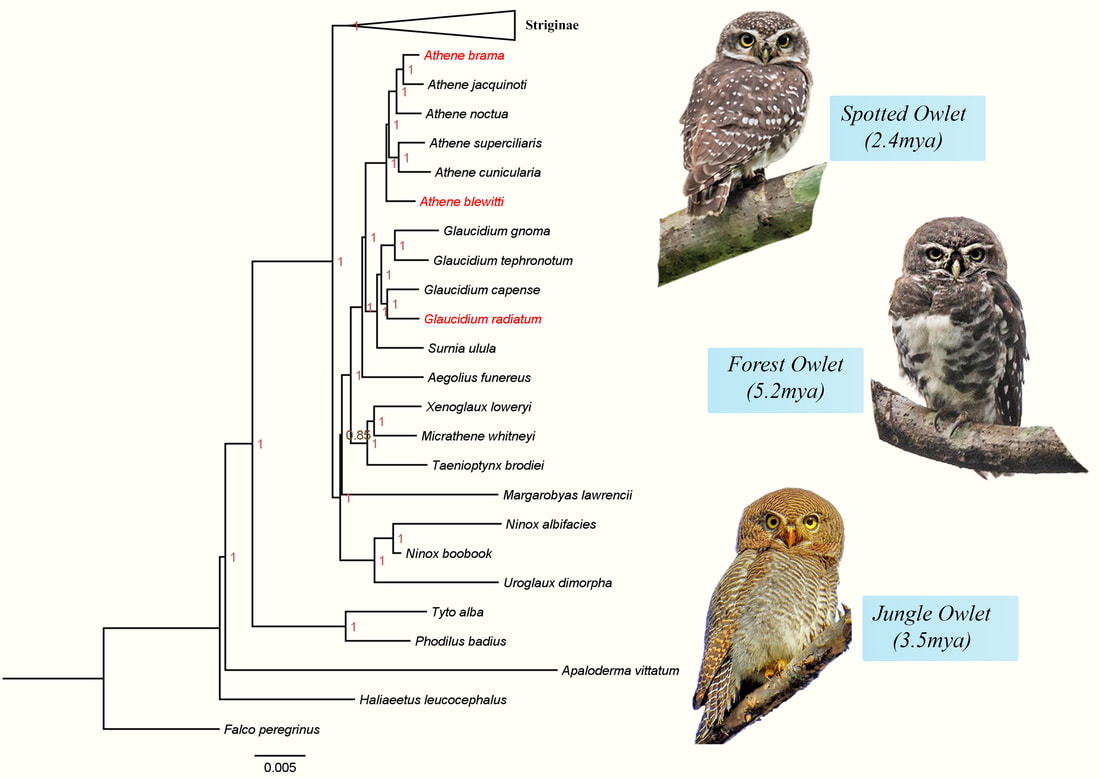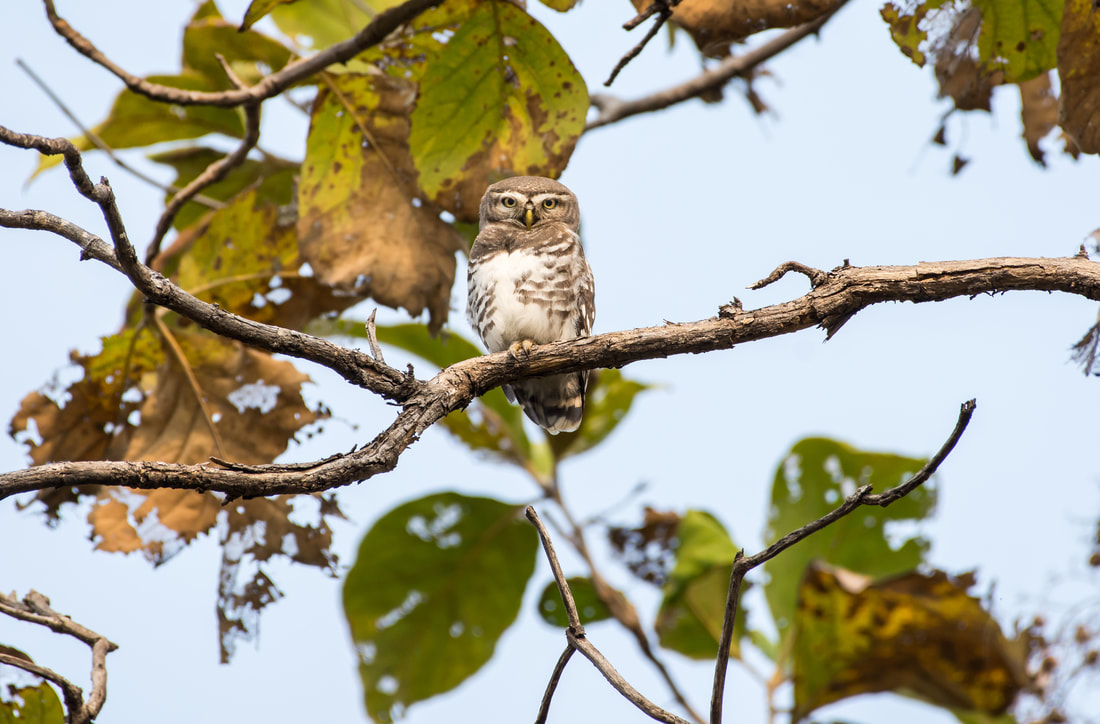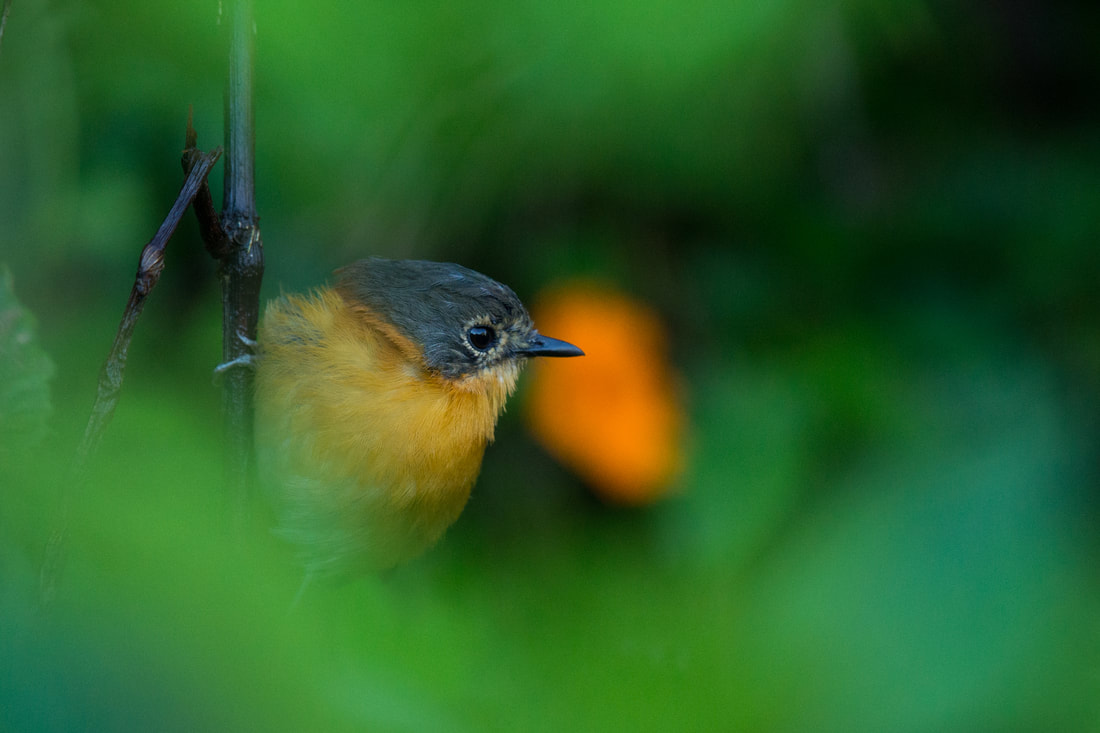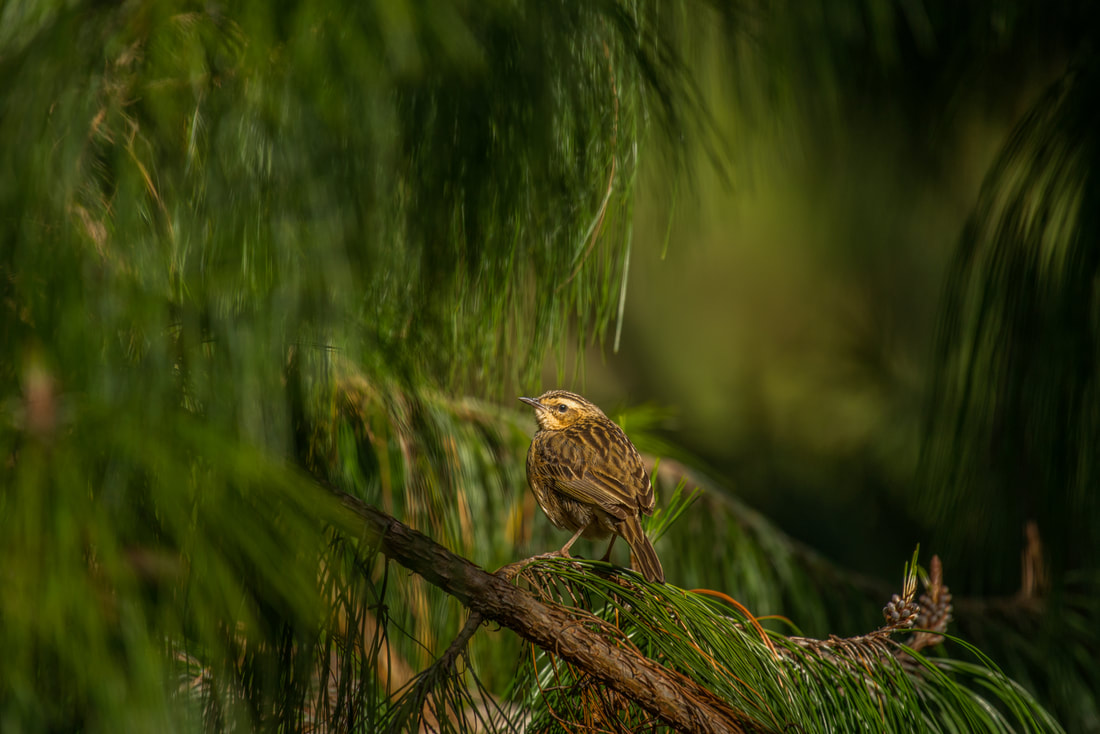Genomics of Forest Owlet
|
Output 1:
Phylogenetic relationships are often challenging to resolve in recent/younger lineage when only a few loci are used. Ultra Conserved Elements (UCE) are highly conserved regions across taxa that help resolve shallow and deep divergences. We utilized UCEs harvested from whole genomes to assess the phylogenetic position and taxonomic affiliation of an endangered endemic owlet in the family Strigidae – the Forest Owlet Athene blewitti. The taxonomic placement of this species has been revised multiple times. A multigene study attempted to address the question but showed a discrepancy across datasets in its placement of the species within genus Athene. We assembled a dataset of 5018 nuclear UCE loci with increased taxon sampling. Forest Owlet was found to be an early split from the Athene clade but sister to other Athene; and consistent across three approaches - maximum likelihood, bayesian, and the multispecies coalescence. |
Divergence dating using fossil calibrations suggest that the Athene lineage split from its ancestor about 7.6Mya, and the Forest Owlet diverged about 5.2Mya, consistent with previous multigene approaches. Despite osteological differences from other Athene, we suggest the placement of the Forest Owlet as a member of the Athene to emphasize its evolutionary relationship.
Output 2:
Climatic oscillations over the Quaternary have had a lasting impact on species’ distribution, evolutionary history, and genetic composition. Many species show dramatic population size changes coinciding with the last glacial period. However, the extent and direction of change vary across biogeographic regions, species-habitat associations, and species traits. Here we use genomic data to assess population size changes over the late Quaternary using the Pairwise Sequential Markovian Coalescent (PSMC) approach in two Eurasian Owlet species—the Spotted Owlet, Athene brama, and the Jungle Owlet, Glaucidium radiatum. While Spotted Owlets are typically associated with open habitats, Jungle Owlets are found in deciduous forests and scrublands. We find that the effective population size for the Spotted Owlet increased after the Interglacial period till the Last Glacial Maxima and subsequently declined toward the Mid-Holocene. On the other hand, effective population size estimates for the Jungle Owlet increased gradually throughout this period. These observations are in line with climatic niche model-based predictions for range size change for both species from a previous study and suggest that habitat associations at the local scale are important in determining responses to past climatic and vegetational changes. The Spotted Owlet result also aligns well with the expectation of open habitat expansion during the arid Glacial Maxima, whereas for the Jungle Owlet the contrasting expectation does not hold. Therefore, assessing the impacts of glacial history on population trajectories of multiple species with different habitat associations is necessary to understand the impacts of past climate on South Asian taxa.
Publications :
Output 2:
Climatic oscillations over the Quaternary have had a lasting impact on species’ distribution, evolutionary history, and genetic composition. Many species show dramatic population size changes coinciding with the last glacial period. However, the extent and direction of change vary across biogeographic regions, species-habitat associations, and species traits. Here we use genomic data to assess population size changes over the late Quaternary using the Pairwise Sequential Markovian Coalescent (PSMC) approach in two Eurasian Owlet species—the Spotted Owlet, Athene brama, and the Jungle Owlet, Glaucidium radiatum. While Spotted Owlets are typically associated with open habitats, Jungle Owlets are found in deciduous forests and scrublands. We find that the effective population size for the Spotted Owlet increased after the Interglacial period till the Last Glacial Maxima and subsequently declined toward the Mid-Holocene. On the other hand, effective population size estimates for the Jungle Owlet increased gradually throughout this period. These observations are in line with climatic niche model-based predictions for range size change for both species from a previous study and suggest that habitat associations at the local scale are important in determining responses to past climatic and vegetational changes. The Spotted Owlet result also aligns well with the expectation of open habitat expansion during the arid Glacial Maxima, whereas for the Jungle Owlet the contrasting expectation does not hold. Therefore, assessing the impacts of glacial history on population trajectories of multiple species with different habitat associations is necessary to understand the impacts of past climate on South Asian taxa.
Publications :
- Natesh, M., Vinay, K. L., Ghosh, S., Jayapal, R., Mukherjee, S., Vijay, N., & Robin, V. V. (2020). Contrasting Trends of Population Size Change for Two Eurasian Owlet Species—Athene brama and Glaucidium radiatum From South Asia Over the Late Quaternary. Frontiers in Ecology and Evolution, 8. https://doi.org/10.3389/fevo.2020.608339
- K. L., V., Natesh, M., Mehta, P., Jayapal, R., Mukherjee, S. and Robin, V.V. (2022), Re-assessing the phylogenetic status and evolutionary relationship of Forest Owlet (Athene blewitti (Hume 1873)) using genomic data. Ibis, 164: 1278-1284. https://doi.org/10.1111/ibi.13097
Prevalence of Avian Malaria in Shola habitats
|
Understanding why some parasites emerge in novel host communities while others do not has broad implications for human and wildlife health. In the case of haemosporidian blood parasites, epidemic wild bird mortalities on oceanic islands have been linked to Plasmodium spp., but not genera like Haemoproteus. Indeed, Haemoproteus is absent from many oceanic islands. By contrast, birds on continental islands share long coevolutionary histories with both Plasmodium and Haemoproteus, and are thus ideal model systems to elucidate eco-evolutionary endpoints associated with these parasites in oceanic islands. Here, we examine eco-evolutionary dynamics of avian haemosporidian in the Shola sky-island archipelago of the Western Ghats, India. Our analyses reveal that compared to Plasmodium, Haemoproteus lineages were highly host-specific and diversified via co-speciation with their hosts.
|
We show that community structure of host-generalist Plasmodium was primarily driven by geographical factors (e.g. biogeographic barriers), while that of host-specialist Haemoproteus was driven by host species barriers (e.g. phylogenetic distance). Consequently, a few host species can harbour a high diversity of Plasmodium lineages which, in turn, are capable of infecting multiple host species. These two mechanisms can act in concert to increase the risk of introduction, establishment, and emergence of novel Plasmodium lineages in island systems.
Publications:
Publications:
Forest owlet
|
The taxonomic position of the Forest Owlet (H. blewitti), an Endangered species, has been a matter of dispute among ornithologists over a century. Before this work, the species was placed in a monotypic genus i.e. Heteroglaux. We used genetic data to explore the evolutionary relationships among the Heteroglaux-Athene-Glaucidium species. Our results indicated that the Forest Owlet is nested within the Athene clade. During the study, we also came up with molecular dating estimate suggestive of Plio-Pleistocene Climate boundary (3-5 Ma) as an important period in which most of the extant Athene members diversified. Taking clues from a previous study on the phylogeny of Heteroglaux-Athene-Glaucidium species, we suspected that climatic fluctuations may have played a role in shaping the geographical distribution of Eurasian owlets.
|
We studied extent of climatically suitable areas in four time periods, namely, Last Interglacial (120 Ka), Last Glacial Maximum (20 Ka), Mid-Holocene (6 Ka), and current (1960-1990). We also calculated climatic heterogeneity across species and time periods. We found that the extent of suitable climate for all the owlets varied across time. The Forest Owlet showed cycles of expansion and reduction, which might explain its current narrow and fragmented distribution. The Spotted Owlet and Jungle Owlet showed progressive expansion, whereas the Little Owl showed drastic reduction in LGM and post-LGM expansion. All the owls were nested in areas with less climatic heterogeneity.
Publications:
• Koparde P, Mehta P, Mukherjee S, Robin V. V. Quaternary climatic fluctuations and resulting climatically suitable areas for Eurasian owlets. Ecology & Evolution. 2019;00:1–11. https://doi.org/10.1002/ece3.5086
• Koparde, P., Prachi Mehta, Sushma Reddy, Uma Ramakrishnan, Shomita Mukherjee* and V. V. Robin*. 2018. The critically endangered forest owlet Heteroglaux blewitti is nested within the currently recognized Athene clade: A century-old debate addressed. PLoS ONE https://doi.org/10.1371/journal.pone.0192359. *Equal authors
Publications:
• Koparde P, Mehta P, Mukherjee S, Robin V. V. Quaternary climatic fluctuations and resulting climatically suitable areas for Eurasian owlets. Ecology & Evolution. 2019;00:1–11. https://doi.org/10.1002/ece3.5086
• Koparde, P., Prachi Mehta, Sushma Reddy, Uma Ramakrishnan, Shomita Mukherjee* and V. V. Robin*. 2018. The critically endangered forest owlet Heteroglaux blewitti is nested within the currently recognized Athene clade: A century-old debate addressed. PLoS ONE https://doi.org/10.1371/journal.pone.0192359. *Equal authors
Sholicola song - geographic variation
|
Bird song is known to vary across isolated landscapes. The Shola Sky Islands, with its natural mountain-top habitats along with the fragmentation from deforestation offers a unique habitat to compare parameters of song that differ across natural and anthropogenic isolation. This study provided some key insights. Various mechanisms of isolation can structure populations and result in cultural and genetic differentiation. Similar to genetic markers, for songbirds, culturally transmitted sexual signals such as breeding song can be used as a measure of differentiation as songs can also be impacted by geographic isolation resulting in population‐level differences in song structure. Several studies have found differences in song structure either across ancient geographic barriers or across contemporary habitat barriers owing to deforestation.
|
However, very few studies have examined the effect of both ancient barriers and recent deforestation in the same system. In this study, we examined the geographic variation in song structure across six populations of the White‐bellied Shortwing, a threatened and endemic songbird species complex found on isolated mountaintops or “sky islands” of the Western Ghats. While some sky islands in the system are isolated by ancient valleys, others are separated by deforestation. We examined 14 frequency and temporal spectral traits and two syntax traits from 835 songs of 38 individuals across the six populations. We identified three major song clusters based on a discriminant model of spectral traits, degree of similarity of syntax features, as well as responses of birds to opportunistic playback. However, some traits like complex vocal mechanisms (CVM), relating to the use of syrinxes, clearly differentiated both ancient and recently fragmented populations. We suggest that CVMs may have a cultural basis and can be used to identify culturally isolated populations that cannot be differentiated using genetic markers or commonly used frequency‐based song traits. Our results demonstrate the use of bird songs to reconstruct phylogenetic groups and impacts of habitat fragmentation even in complex scenarios of historic and contemporary isolation.
Publications:
• Chetana Purushottam and V.V. Robin. 2016. Sky Island bird populations isolated by ancient genetic barriers are characterized by different song traits than those isolated by recent deforestation. Ecology and Evolution. 6: 7334–7343. DOI: 10.1002/ece3.2475
Publications:
• Chetana Purushottam and V.V. Robin. 2016. Sky Island bird populations isolated by ancient genetic barriers are characterized by different song traits than those isolated by recent deforestation. Ecology and Evolution. 6: 7334–7343. DOI: 10.1002/ece3.2475
Comparing acoustic indices
|
Automated Recording Units (ARUs) collect a lot of data and very often it is not possible to examine and validate each sound. Some of the initial methods of dealing with such data involved measuring acoustic complexity of sounds produced. With collaborators Rachel Buxton, Rohini Balakrishnan and others we provided one such assessment from a landscape in Western Ghats. Passive acoustic monitoring is a potentially valuable tool in biodiversity hotspots, where surveying can occur at large scales across land conversion types. However, in order to extract meaningful biological information from resulting enormous acoustic datasets, rapid analytical techniques are required. Here we tested the ability of a suite of acoustic indices to predict avian bioacoustic activity in recordings collected from the Western Ghats, a biodiversity hotspot in southwestern India.
|
Recordings were collected at 28 sites in a range of land-use types, from tea, coffee, and cardamom plantations to remnant forest stands. Using 36 acoustic indices we developed random forest models to predict the richness, diversity, and total number of avian vocalizations observed in recordings. We found limited evidence that acoustic indices predict the richness and total number of avian species vocalizations in recordings (R2 < 0.51). However, acoustic indices predicted the diversity of avian species vocalizations with high accuracy (R2 = 0.64, mean squared error = 0.17). Index models predicted low and high diversity best, with the highest residuals for medium diversity values and when continuous biological sounds were present (e.g., insect sounds >8 sec). The acoustic complexity index and roughness index were the most important for predicting avian vocal diversity. Avian species richness was generally higher among shade-grown crops than in the open tea plantation. Our results suggest that models incorporating acoustic indices can accurately predict low and high avian species diversity from acoustic recordings. Thus, ecoacoustics could be an important contributor to biodiversity monitoring across landscapes like the Western Ghats, which are a complex mosaic of different land-use types and face continued changes in the future.
Publications:
• Buxton R. T., Agnihotri S., Robin V. V., Goel A., and Balakrishnan R. 2018. Acoustic indices as rapid indicators of avian diversity in different land-use types in an Indian biodiversity hotspot. Journal of Ecoacoustics. 2: #GWPZVD. https://doi.org/10.22261/JEA.GWPZVD
Publications:
• Buxton R. T., Agnihotri S., Robin V. V., Goel A., and Balakrishnan R. 2018. Acoustic indices as rapid indicators of avian diversity in different land-use types in an Indian biodiversity hotspot. Journal of Ecoacoustics. 2: #GWPZVD. https://doi.org/10.22261/JEA.GWPZVD
Grassland loss and impacts on a specialist bird - Nilgiri Pipit
|
Tropical montane habitats support high biodiversity, and are hotspots of endemism, with grasslands being integral components of many such landscapes. The montane grasslands of the Western Ghats have seen extensive land-use change over anthropogenic timescales. The factors influencing the ability of grassland-dependent species to persist in habitats experiencing loss and fragmentation, particularly in montane grasslands, are poorly known. We studied the relationship between the Nilgiri pipit Anthus nilghiriensis, a threatened endemic bird that typifies these montane grasslands, and its habitat, across most of its global distribution. We examined what habitat features make remnants viable habitat, which is necessary for effective management.
|
We examined what habitat features make remnants viable habitat, which is necessary for effective management. We conducted 663 surveys in 170 sites and used both single-season occupancy modelling and N-mixture modelling to account for processes influencing detection, presence, and abundance. Elevation had a positive influence on species presence, patch size had a moderate positive influence and patch isolation a moderate negative influence. Species abundance was positively influenced by elevation and characteristics related to habitat structure, and negatively influenced by the presence of invasive woody vegetation. The strong effect of elevation on the highly range-restricted Nilgiri pipit makes it vulnerable to, and an indicator of, climate change. This highly range-restricted species is locally extinct at several locations and persists at low densities in remnants of recent fragmentation, suggesting an extinction debt. Our findings indicate a need to control and reverse the spread of exotic woody invasives to preserve the grasslands themselves and the specialist species dependent upon them.
Publications:
• Lele, A., Arasumani, M., Vishnudas, C. K., Jathanna, D., & Robin, V. V. (2019). Local extinction of a montane, endemic grassland bird driven by landscape change across its global distribution. bioRxiv, 695536.
Publications:
• Lele, A., Arasumani, M., Vishnudas, C. K., Jathanna, D., & Robin, V. V. (2019). Local extinction of a montane, endemic grassland bird driven by landscape change across its global distribution. bioRxiv, 695536.






